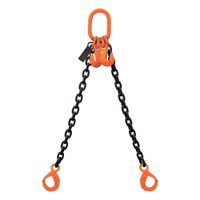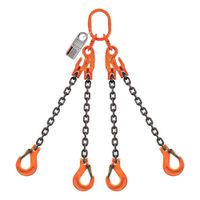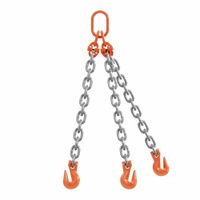Call +(254) 703 030 000 / 751 483 999 / 721 704 777
- Home
- Material Handling
- Lifting Pulling Positioning
- Lifting Slings
- Chain Slings
.....Read More
Frequently Asked Questions
What are chain slings used for?
Chain slings are lifting devices used in material handling and rigging operations to lift, move, and secure heavy loads. They are composed of high-strength alloy steel chains and are favored for their durability, flexibility, and resistance to abrasion, corrosion, and high temperatures. Chain slings are commonly used in industries such as construction, manufacturing, shipping, and mining.
The primary use of chain slings is to lift and transport heavy objects safely and efficiently. They are designed to handle loads of various shapes and sizes, making them versatile for different lifting applications. Chain slings can be configured in multiple ways, such as single-leg, double-leg, triple-leg, or quadruple-leg, depending on the weight and balance requirements of the load.
Chain slings are particularly useful in environments where the load may have sharp edges or where the lifting conditions are harsh, as they can withstand rough handling and extreme conditions better than other types of slings, such as wire rope or synthetic slings. They are also adjustable, allowing for precise control over the load during lifting operations.
In addition to lifting, chain slings are used for securing loads during transport, ensuring that heavy items remain stable and do not shift, which is crucial for safety. They are also employed in load binding applications, where they help in tightening and securing loads on flatbeds or trailers.
Overall, chain slings are essential tools in heavy-duty lifting and rigging operations, providing strength, reliability, and adaptability to meet the demands of various industrial applications.
How do you determine the capacity of a chain sling?
To determine the capacity of a chain sling, consider the following factors:
1. **Grade of Chain**: Identify the grade of the chain, such as Grade 80 or Grade 100, which indicates the strength and load-bearing capacity.
2. **Chain Size**: Measure the diameter of the chain links. Larger diameters generally support heavier loads.
3. **Sling Configuration**: Determine the sling configuration (e.g., single, double, triple, or quadruple leg). Each configuration affects the load distribution and capacity.
4. **Angle of Lift**: Assess the angle between the sling legs and the horizontal. Smaller angles increase tension and reduce capacity. Use the angle factor from load charts to adjust capacity.
5. **Load Charts**: Refer to manufacturer-provided load charts specific to the chain grade and size. These charts list the Working Load Limit (WLL) for different configurations and angles.
6. **Sling Length**: Consider the length of the sling, as longer slings may require adjustments in capacity due to increased angles.
7. **Environmental Factors**: Account for environmental conditions such as temperature, which can affect the material properties and capacity.
8. **Wear and Tear**: Inspect the chain for wear, deformation, or damage. Any defects can significantly reduce capacity.
9. **Regulatory Standards**: Ensure compliance with relevant standards and regulations, such as OSHA or ASME, which provide guidelines for safe lifting capacities.
10. **Safety Factor**: Apply a safety factor to account for uncertainties and ensure safe operation. This is typically a reduction from the maximum capacity.
By considering these factors, you can accurately determine the safe working capacity of a chain sling for lifting operations.
What are the different types of chain slings?
Chain slings are categorized based on their configuration and the number of legs they have. The main types include:
1. **Single-Leg Chain Sling**: Consists of one chain leg with a hook or other attachment at the end. It's used for straight lifting applications.
2. **Double-Leg Chain Sling**: Features two chain legs, allowing for more stability and balance when lifting loads. It's suitable for lifting objects with two attachment points.
3. **Triple-Leg Chain Sling**: Comprises three chain legs, providing even greater stability. It's ideal for lifting loads with three attachment points, distributing the weight more evenly.
4. **Quadruple-Leg Chain Sling**: Contains four chain legs, offering maximum stability and balance. It's used for lifting heavy and irregularly shaped loads with four attachment points.
5. **Endless Chain Sling**: A continuous loop of chain that can be used in a choker or basket hitch configuration. It's versatile and can adjust to different load shapes.
6. **Adjustable Chain Sling**: Equipped with a mechanism to adjust the length of the chain legs, allowing for flexibility in handling various load sizes and shapes.
7. **Basket Chain Sling**: Utilizes two or more chain legs to form a basket shape, cradling the load. It's effective for lifting cylindrical or rounded objects.
8. **Choker Chain Sling**: Designed to tighten around the load when lifted, providing a secure grip. It's used for lifting loads that might slip out of other sling types.
Each type of chain sling is selected based on the specific lifting requirements, including the weight, shape, and balance of the load.
How do you inspect a chain sling for safety?
To inspect a chain sling for safety, follow these steps:
1. **Visual Inspection**: Examine the entire length of the chain for any signs of wear, corrosion, or damage. Look for bent, twisted, or stretched links.
2. **Check Identification Tags**: Ensure the sling has a legible identification tag with the manufacturer's name, grade, size, and working load limit.
3. **Inspect Links**: Look for cracks, gouges, or excessive wear on the links. Measure the link dimensions to ensure they are within the manufacturer's specifications.
4. **Examine Hooks and Attachments**: Check hooks for deformation, cracks, or wear. Ensure latches are functioning properly and are not bent or distorted.
5. **Assess Wear and Stretch**: Measure the chain for elongation. If the chain has stretched beyond the manufacturer's allowable limits, it should be removed from service.
6. **Check for Twisting**: Ensure the chain is not twisted or kinked, as this can reduce its strength and lead to failure.
7. **Inspect Welds**: If the chain has welded components, check for cracks or defects in the welds.
8. **Look for Corrosion**: Check for rust or corrosion, especially in areas that may have been exposed to harsh environments.
9. **Test Functionality**: Ensure all moving parts, such as hooks and latches, operate smoothly without sticking.
10. **Consult Manufacturer's Guidelines**: Follow the manufacturer's inspection criteria and guidelines for specific inspection intervals and procedures.
11. **Document Findings**: Record the inspection results, noting any defects or issues found, and take corrective action if necessary.
12. **Remove from Service**: If any defects are found that compromise the safety of the sling, remove it from service immediately and replace or repair it as needed.
What are the advantages of using chain slings over other types of slings?
Chain slings offer several advantages over other types of slings, such as wire rope or synthetic slings:
1. **Durability**: Chain slings are highly durable and resistant to abrasion, cutting, and high temperatures, making them suitable for harsh environments and heavy-duty applications.
2. **Strength**: They provide superior strength and can handle heavy loads, making them ideal for lifting large, heavy objects.
3. **Adjustability**: Chain slings can be easily adjusted in length by adding or removing links, offering flexibility in various lifting scenarios.
4. **Versatility**: They can be used in a wide range of configurations, including single, double, triple, or quadruple leg setups, accommodating different lifting needs.
5. **Resistance to Environmental Factors**: Chain slings are less affected by chemicals, UV radiation, and moisture, which can degrade other sling materials over time.
6. **Inspection and Maintenance**: Chains are easier to inspect for damage or wear, and individual links can be replaced, extending the sling's lifespan.
7. **Temperature Tolerance**: They can withstand high temperatures without losing strength, unlike synthetic slings that may weaken or melt.
8. **Safety**: Chain slings are less likely to fail suddenly, providing a higher level of safety during lifting operations.
9. **Load Stability**: The weight and rigidity of chain slings help stabilize loads, reducing the risk of swinging or shifting during lifts.
10. **Cost-Effectiveness**: Although the initial cost may be higher, their longevity and low maintenance requirements can make them more cost-effective in the long run.
These advantages make chain slings a preferred choice in industries such as construction, manufacturing, and shipping, where reliability and safety are paramount.
How do you properly maintain a chain sling?
To properly maintain a chain sling, follow these steps:
1. **Inspection**: Regularly inspect the chain sling before each use. Look for signs of wear, deformation, cracks, nicks, gouges, and corrosion. Pay special attention to the links, hooks, and other components.
2. **Cleaning**: Keep the chain sling clean. Remove dirt, grease, and other contaminants using a wire brush or a non-corrosive cleaning agent. Avoid using harsh chemicals that could damage the metal.
3. **Lubrication**: Apply a light coat of lubricant to the chain to prevent rust and ensure smooth operation. Use a lubricant that is suitable for the working environment and does not attract dirt.
4. **Storage**: Store the chain sling in a dry, cool place away from direct sunlight and corrosive environments. Hang it on a rack or peg to prevent tangling and damage.
5. **Load Testing**: Conduct periodic load testing as per the manufacturer's recommendations or industry standards to ensure the chain sling can handle its rated capacity.
6. **Repair and Replacement**: Immediately remove from service any chain sling that shows signs of damage or wear beyond acceptable limits. Replace damaged components or the entire sling if necessary. Only qualified personnel should perform repairs.
7. **Documentation**: Maintain records of inspections, maintenance, and repairs. This documentation helps track the condition of the chain sling and ensures compliance with safety regulations.
8. **Training**: Ensure that all personnel handling chain slings are properly trained in their use, inspection, and maintenance procedures.
By following these steps, you can extend the life of a chain sling and ensure safe lifting operations.
What safety precautions should be taken when using chain slings?
1. **Inspection**: Regularly inspect chain slings for wear, damage, or deformation. Check for cracks, elongation, or corrosion.
2. **Load Limits**: Adhere to the Working Load Limit (WLL) specified by the manufacturer. Never exceed the rated capacity.
3. **Proper Use**: Ensure the chain sling is suitable for the type of load and lifting conditions. Use the correct hitch type (vertical, choker, or basket).
4. **Angle Considerations**: Be mindful of the angle of the sling. Larger angles reduce the effective capacity of the sling.
5. **Temperature**: Avoid using chain slings in extreme temperatures unless they are specifically designed for such conditions.
6. **Sharp Edges**: Protect the chain from sharp edges on the load with padding or corner protectors to prevent damage.
7. **Storage**: Store chain slings in a clean, dry place away from chemicals and corrosive environments. Hang them to prevent kinks and twists.
8. **Training**: Ensure all personnel involved in lifting operations are properly trained in the use of chain slings.
9. **Tagging**: Ensure slings are properly tagged with identification and load capacity information.
10. **Avoid Twisting**: Do not twist or knot the chain sling, as this can reduce its strength.
11. **Balanced Load**: Ensure the load is balanced and stable before lifting. Use multiple slings if necessary to achieve balance.
12. **Avoid Shock Loading**: Lift and lower loads smoothly to avoid shock loading, which can cause sudden stress on the sling.
13. **Environmental Factors**: Be aware of environmental factors such as wind or rain that may affect the lifting operation.
14. **Communication**: Maintain clear communication among all team members involved in the lifting operation.
15. **Emergency Procedures**: Have emergency procedures in place in case of sling failure or other incidents.



